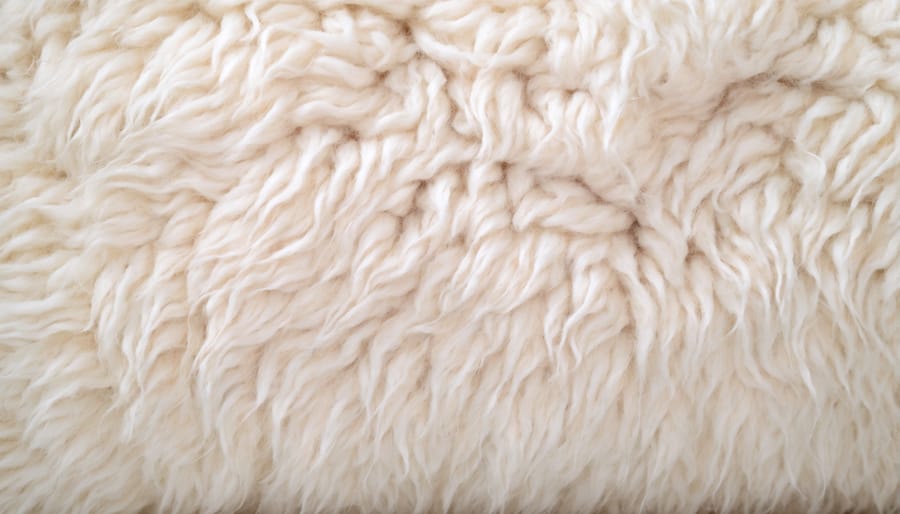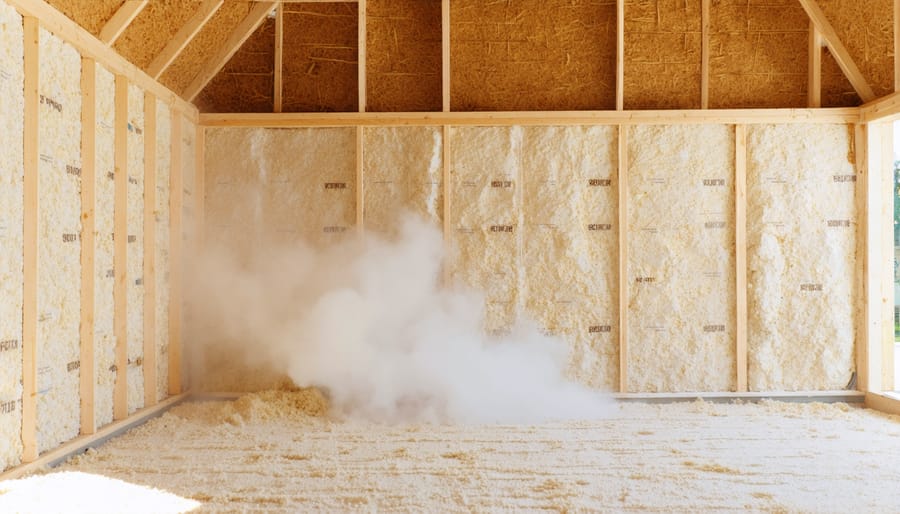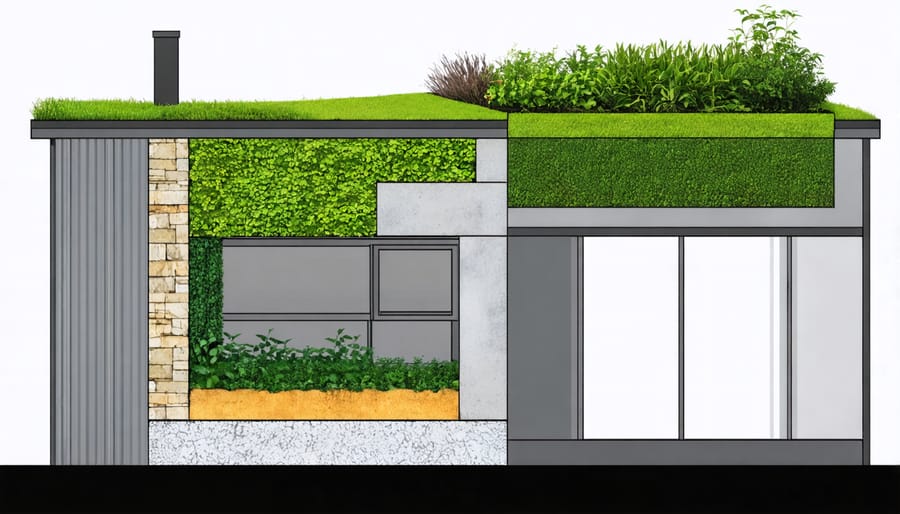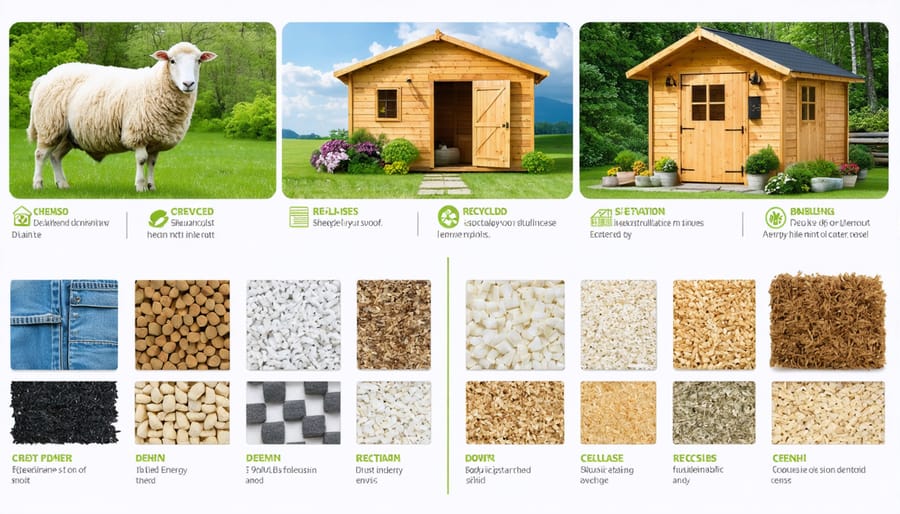Transform your shed into an energy-efficient sanctuary with sustainable insulation that slashes heating costs while protecting our planet. Natural fiber materials like hemp, cotton, and sheep’s wool offer superior thermal performance without harmful chemicals, creating healthier storage spaces that maintain effective climate control year-round. Modern recycled options, including cellulose from processed newspaper and reclaimed denim, deliver exceptional R-values while diverting waste from landfills. These eco-conscious solutions not only regulate temperature more consistently than traditional fiberglass but also absorb sound, resist mold, and maintain their insulating properties for decades. By choosing sustainable insulation, shed owners can reduce their carbon footprint while creating more comfortable, durable spaces that add lasting value to their property.
Natural Fiber Insulation Solutions
Sheep’s Wool: Nature’s Perfect Insulator
Among the many sustainable building materials available today, sheep’s wool stands out as a remarkable natural insulator. This renewable resource offers exceptional temperature regulation while being completely biodegradable and eco-friendly. Unlike synthetic alternatives, wool naturally manages moisture, absorbing and releasing it to maintain optimal humidity levels in your shed.
Installing wool insulation is straightforward and safe, requiring no special protective equipment. The fibers can be easily tucked between studs and joists, making it perfect for DIY projects. What’s particularly impressive is wool’s natural fire resistance – it won’t burn but rather self-extinguishes, adding an extra layer of safety to your storage space.
Wool insulation also excels at sound dampening and can last for decades without losing its effectiveness. While it may cost more initially than traditional options, its durability and energy-saving properties make it a smart long-term investment. For those concerned about pests, rest assured that wool insulation typically comes treated with natural borax, making it resistant to insects and mold while remaining environmentally friendly.

Cotton and Denim: From Old Jeans to New Insulation
Transform your old jeans and cotton clothing into effective, eco-friendly insulation for your shed. This innovative recycling solution not only keeps textiles out of landfills but also creates a highly effective insulating material. Recycled denim insulation performs similarly to traditional fiberglass, with the added benefit of being safer to handle and naturally fire-resistant.
The process involves shredding old cotton materials into fibers, which are then treated with a natural fire retardant and formed into batts or loose-fill insulation. This recycled material achieves an impressive R-value of 3.5 per inch, making it comparable to conventional options while being more environmentally responsible.
Many homeowners appreciate that denim insulation is free from harmful chemicals and doesn’t cause skin irritation during installation. It also provides excellent sound absorption, creating a quieter environment in your shed. While the initial cost might be slightly higher than traditional insulation, the environmental benefits and improved indoor air quality make it a worthwhile investment for eco-conscious shed owners.
Consider collecting old jeans and cotton materials from family and friends, or check with local recycling centers that specialize in textile collection for insulation purposes.
Recycled Material Options
Cellulose: Yesterday’s News, Today’s Warmth
Ever wondered what happens to yesterday’s newspapers? They might just be keeping someone’s shed cozy today! Cellulose insulation, made from recycled paper products, is one of the most eco-friendly insulation options available. This sustainable solution puts old newspapers, cardboard, and other paper materials to excellent use instead of letting them pile up in landfills.
What makes cellulose particularly appealing is its impressive R-value, matching or even exceeding that of traditional insulation materials. When properly installed, it creates a dense barrier that effectively keeps heat where you want it – inside during winter and outside during summer.
Installation typically involves blowing the treated cellulose into wall cavities or attic spaces. While this usually requires professional equipment, the material itself is safe to handle and contains no harmful chemicals. The paper is treated with natural fire retardants like boric acid, making it both fire-resistant and pest-resistant.
Beyond its environmental benefits, cellulose insulation is budget-friendly and helps reduce energy costs throughout the year. It’s particularly effective at filling small gaps and corners, creating a more complete thermal barrier than many alternatives.

Recycled Plastic Insulation
Recycled plastic insulation represents an innovative solution that transforms post-consumer plastic waste into effective shed insulation. Made primarily from recycled PET bottles and other plastic materials, this insulation option offers excellent thermal performance while helping reduce landfill waste. The manufacturing process involves breaking down plastic into fibers, which are then bonded together to create insulation batts or rolls that are both moisture-resistant and durable.
Many homeowners appreciate that recycled plastic insulation is easy to handle and install, with no special protective equipment required. It’s also non-toxic and doesn’t contain harmful chemicals often found in traditional insulation materials. The insulation typically maintains its shape and performance for many years, making it a reliable long-term solution for your shed.
One of the most appealing aspects is its eco-friendly credentials – each square meter of recycled plastic insulation can repurpose up to 60 plastic bottles. This type of insulation also offers good acoustic properties, helping to reduce noise transfer while maintaining comfortable temperatures in your shed year-round.
DIY Sustainable Solutions
Natural Reflective Barriers
Natural reflective barriers offer an innovative approach to sustainable insulation by using materials that effectively bounce heat away from your shed. One of the most popular options is aluminum foil-faced bubble wrap, which combines recycled materials with excellent reflective properties. This eco-friendly solution creates a barrier that reflects up to 97% of radiant heat, helping maintain comfortable temperatures year-round.
Pine needles, straw, and other natural materials can be strategically placed between wall layers to create additional reflective barriers. These materials are readily available, biodegradable, and often free or low-cost. When properly installed with an air gap, they can significantly reduce heat transfer while maintaining their effectiveness over time.
Another effective natural reflective option is cork panels. Not only is cork renewable and biodegradable, but its cellular structure also creates tiny air pockets that reflect heat. Cork’s natural properties make it an excellent insulator that’s both sustainable and aesthetically pleasing.
Light-colored or white natural clay plaster can also serve as a reflective barrier. When applied to interior walls, it reflects light and heat while allowing the structure to breathe. This traditional technique has been used for centuries and continues to prove its worth in modern sustainable building practices.
For optimal results, combine these natural reflective barriers with proper ventilation and strategic placement. This approach maximizes their effectiveness while maintaining the eco-friendly benefits you’re looking for.
Green Roofing Integration
Combining sustainable insulation with eco-friendly roofing options like green roofs creates a powerful duo for energy efficiency and environmental benefits. A green roof system consists of vegetation layers that work in harmony with your insulation to provide additional temperature regulation and protection for your shed.
When integrating a living roof with your insulation, start with a sturdy waterproof membrane to prevent moisture damage. Layer your chosen sustainable insulation material, such as sheep’s wool or recycled cotton, beneath the green roof components. The vegetation and soil layers act as natural insulators themselves, working alongside your primary insulation to maintain comfortable temperatures year-round.
The benefits of this combination are impressive: enhanced insulation performance, extended roof life, improved stormwater management, and creation of a mini ecosystem that supports local wildlife. Many homeowners report that their green roof integration has reduced their shed’s internal temperature fluctuations by up to 25% compared to traditional roofing.
Consider starting with drought-resistant sedum plants or native species that require minimal maintenance. The soil depth can be as shallow as 4-6 inches for most shed applications, making this a viable option for many existing structures. Remember to ensure your shed’s structure can support the additional weight of the green roof system before installation.

Installation and Maintenance Tips
Installing sustainable insulation properly is key to maximizing its effectiveness and longevity. Start by thoroughly cleaning the installation area and checking for any moisture issues or damage that needs addressing. Wear appropriate protective gear, including gloves, goggles, and a dust mask, especially when handling natural fiber insulation materials.
For rolls or batts of sustainable insulation, measure and cut pieces slightly larger than the space to ensure a snug fit. When installing between studs or joists, avoid compressing the material, as this reduces its insulating properties. Use vapor barriers where appropriate, particularly in areas with high moisture levels.
For loose-fill options like cellulose or wool, ensure even distribution throughout the space. Consider hiring a professional for spray foam applications, as these require specific equipment and expertise for optimal results.
Regular maintenance is straightforward but essential. Conduct visual inspections twice yearly, checking for signs of settling, moisture damage, or pest activity. Pay special attention to areas around pipes, vents, and other penetrations where air leaks commonly occur.
If you notice any dampness, address the source immediately to prevent mold growth. Most sustainable insulation materials are naturally resistant to pests, but it’s still wise to monitor for any unwanted visitors.
For long-term care, ensure proper ventilation throughout your space to prevent moisture buildup. Keep gutters clean and maintain good drainage around your foundation to protect ground-level insulation. If repairs are needed, patch small areas promptly to maintain the insulation’s effectiveness and prevent larger issues from developing.
Remember, proper installation and maintenance not only extend the life of your sustainable insulation but also maximize its energy-saving benefits.
Choosing sustainable insulation for your shed is more than just an eco-friendly decision – it’s an investment in both your property and our planet’s future. Natural and recycled materials offer excellent thermal performance while reducing your carbon footprint and energy costs. By selecting options like sheep’s wool, recycled denim, or cellulose, you’re creating a healthier environment inside your shed while contributing to a more sustainable world outside it. The initial cost of sustainable insulation often pays for itself through lower energy bills and increased durability. As more homeowners embrace these green alternatives, we’re seeing improved availability and competitive pricing across the market. Make the smart choice for your shed, your wallet, and the environment by considering sustainable insulation options for your next project.





Leave a Reply